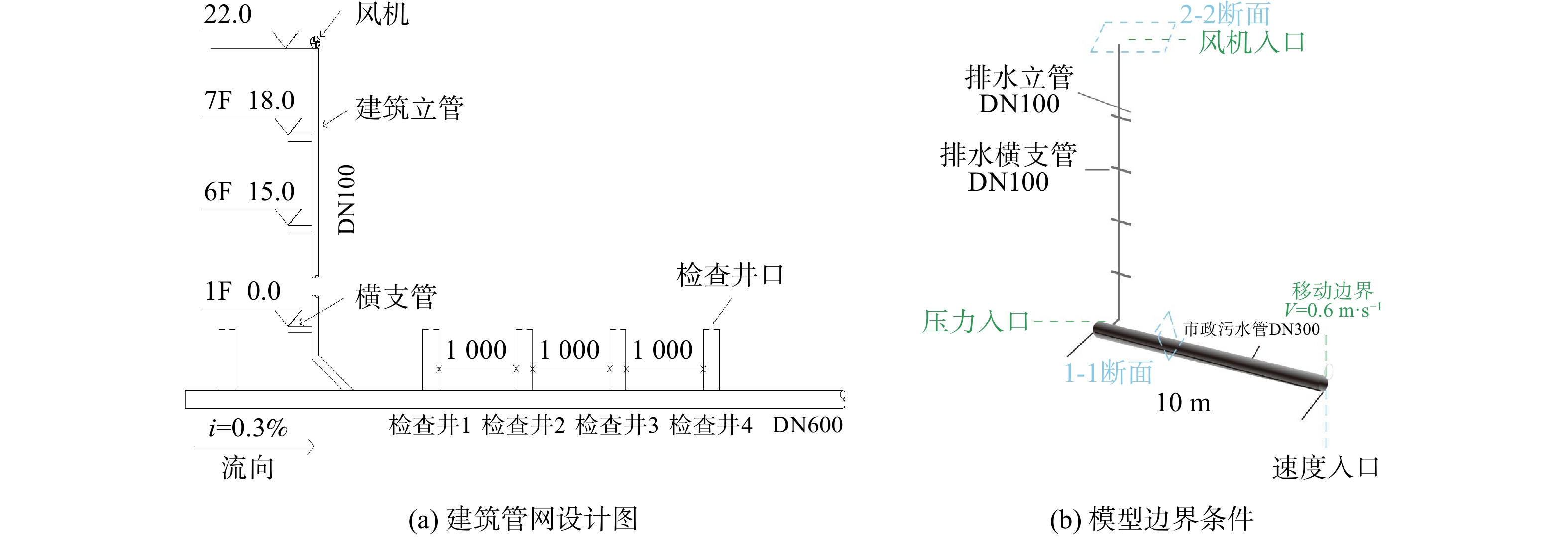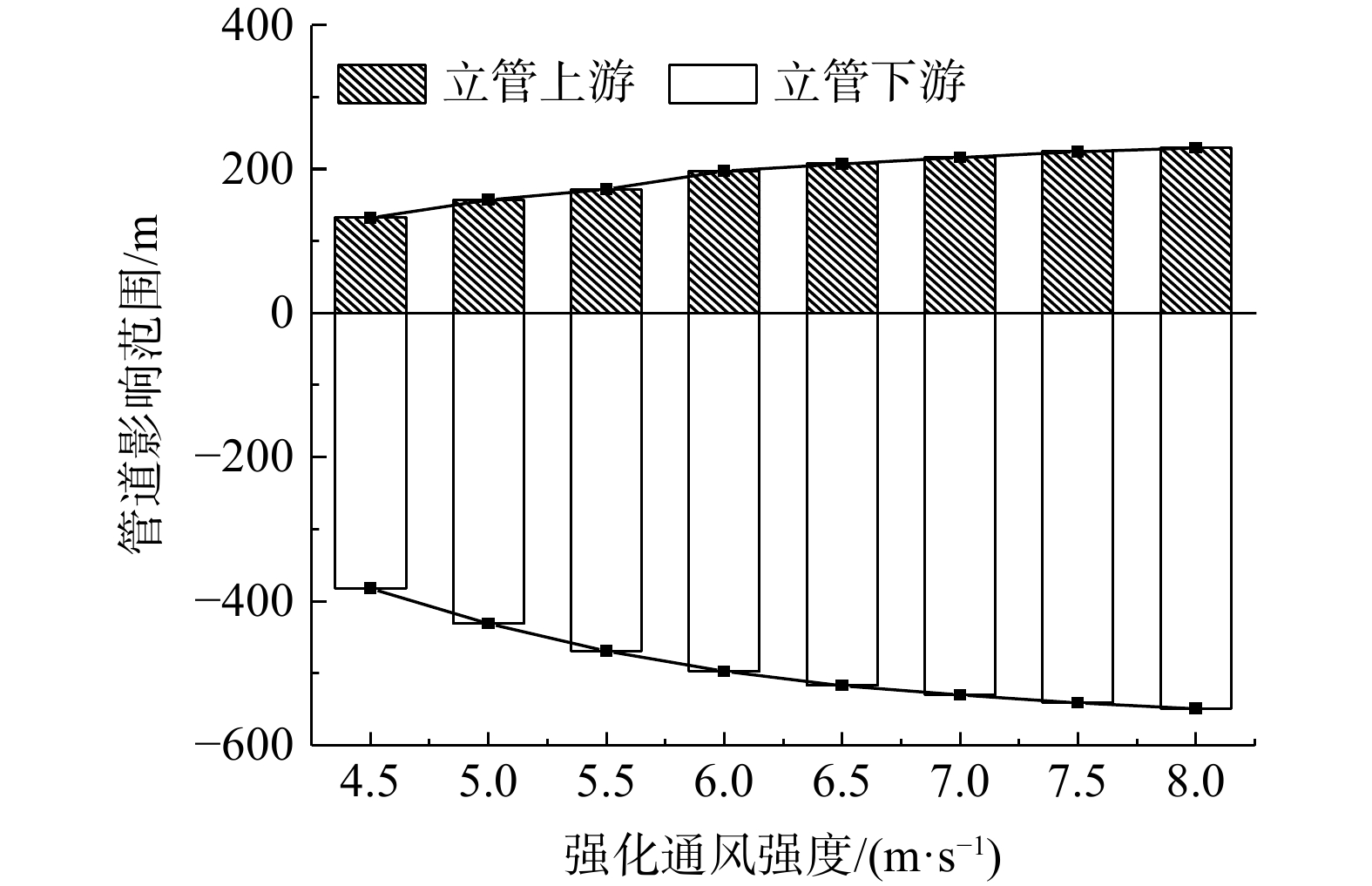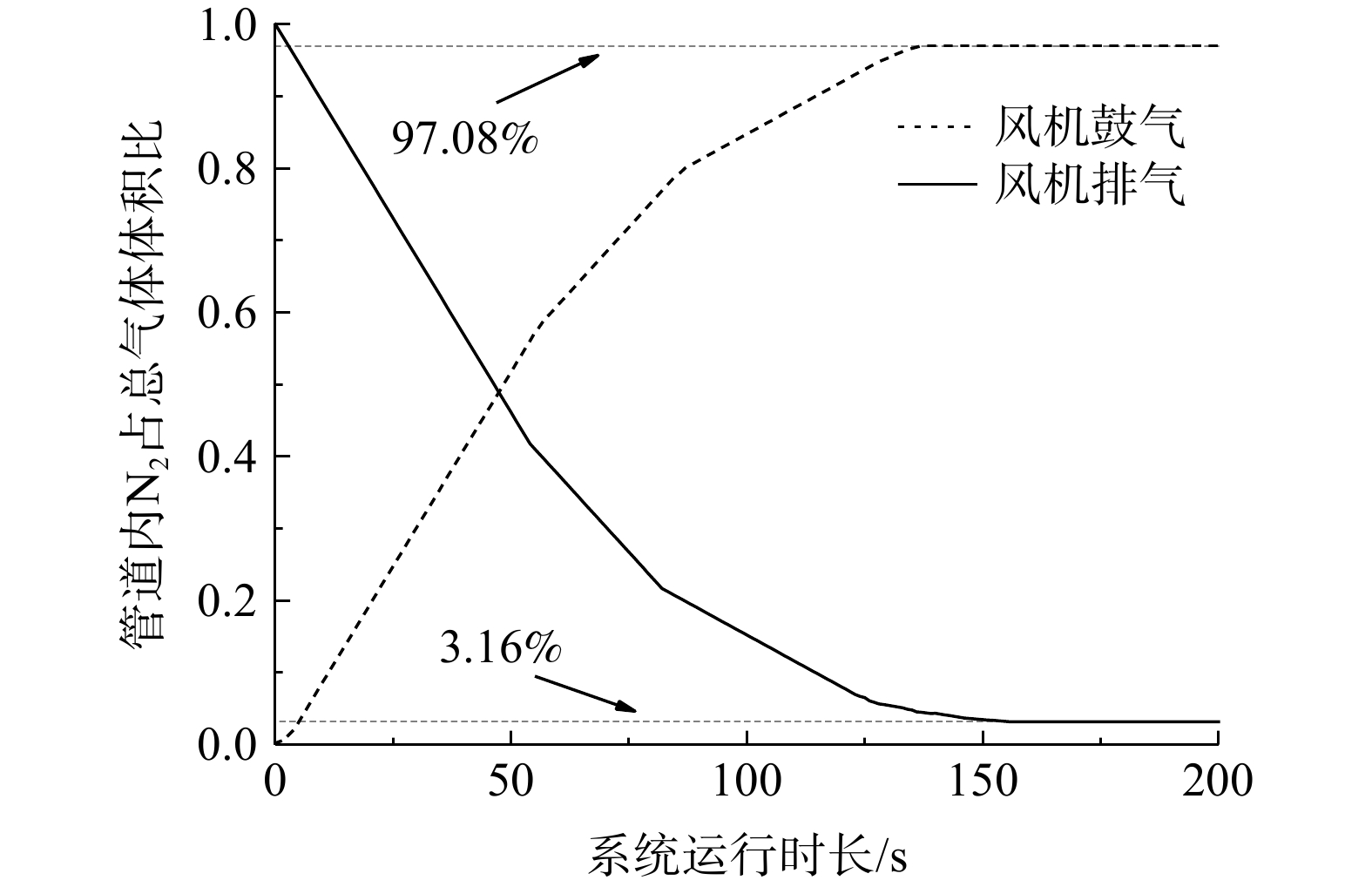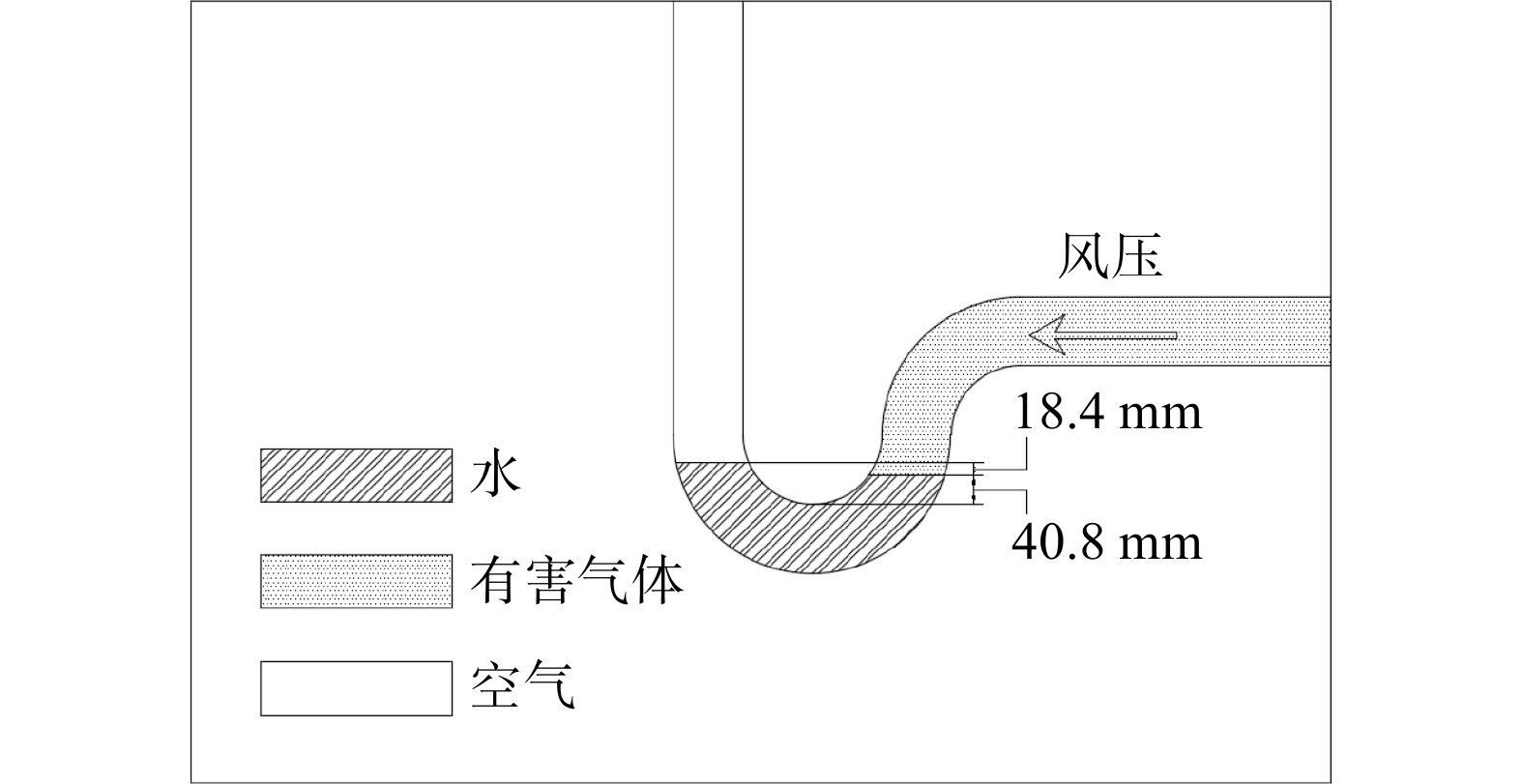-
城市污水管道通过一般检查孔与外界环境进行气体交换,故通风效果有限,难以及时补充污水中被微生物消耗的溶解氧(dissolved oxygen ,DO),极易形成厌氧环境[1],从而导致厌氧气体积累,甚至可能发生爆炸事故。控制污水管道爆炸性气体的方式有:通过鼓风充气以抑制厌氧生物膜的活性,减少 H2S 和 CH4 的产生[2];通过投加化学药剂(包括氢氧化钠、硝酸盐、金属盐等)来抑制厌氧气体产生的措施[3-6]。上述措施一般需持续性的操作,药剂投加和特殊的操作条件均使得城市管网的管理成本增加[7]。
目前,国内城市建筑密度大、污水管道长,有必要建立一种消除 CH4 爆炸性隐患的可持续方法。张二飞等[8]探究了建筑排水立管未经化粪池直接接入污水管网的气流规律,发现立管带入气体有94%用于改善污水管道顶部的气相环境。该方法能改善污水管网通风状态的长度为5~32 m,对于密集的城市污水管网而言,其改善长度有限。高如月等[9]使用脉冲通气方法在水流速度为 0.2 m·s−1时,可实现对有害气体的最佳控制效果,但该方法同样面临改善区域有限的问题。卢金锁等[10]从整个污水集输管道系统角度出发,探讨了化粪池对气流组织的隔断效应,发现利用排水立管连通大气可降低污水管道中有害气体的浓度。而污水管道内外气体的温度、湿度差异会影响自然通风效果[11],故自然通气控制方法的影响范围有限。硫酸盐还原菌(sulfate-reducing bacteria,SRB)受高温影响在夏季管道中会产生更多CH4[12],夏季高温情况下,CH4与干空气密度差减小,建筑立管直接与污水管道相连的通风效果会受到一定限制。
基于上述背景,本课题组提出一种用风机推动建筑物直立管道及污水管道中气相流动,以增强污水管道通风、控制有害气体安全风险的新方法,其风机系统如图1所示。通过在上下游建筑立管顶部分别安装风机,使得上游立管向内鼓入新鲜气体,下游立管向外排出有害气体并设置气体吸附装置。该方法可使建筑立管与污水管道直接相连以改善通风,且不受制与管道内外温度差(如夏季高温)的影响,还可以增加建筑立管在排水时所需补气量,加强建筑立管与污水管道直接相连对下水道通风状态的影响长度。将该方法应用于西安市某建筑的部分污水管道,建立了通风效能的计算流体力学(CFD)模型,并进行现场实验验证,以期为城市污水管道中有害气体的控制提供参考。
-
西安市某建筑立管不经化粪池直接与污水管道相连,为实验提供了可操作空间,如图2(a)所示。以此建筑为原型,运用CFD 建立与图2比例为 1:1的模型,计算尺寸和边界条件设置情况,如图2(b)所示。
该建筑中楼层建筑立管高度为22 m,管径为DN100,于建筑立管伸顶通气顶部安装风机。选用4寸口径大小的风机,风量310~330 m·h−1、风速7~8 m·s−1、风压180 Pa、功率40 W,检查井深1.4 m,间隔1 m。 CFD模拟风机运行风速设置7.5 m·s−1,污水管道充满度为 0.5,底部水流流速为 0.6 m·s−1。
-
采用二维数值模拟的基本方程,包括质量守恒方程、能量守恒方程、动量守恒方程、标准方程等,具体内容见表1。采用有限体积法进行求解方程,湍流耗散率、湍动能方程使用二阶迎风格式求解。模拟实验为管道中气流流动情况,为尽量贴近实际管道中气流流动,采用多相流VOF模型,模拟管道中气液两相流动情况。其中,建筑立管不排水时污水管道中气液流动相对平缓,湍动能方程和耗散率设置为一阶迎风格式,后续模拟建筑立管排水情况时湍动能方程和耗散率设置改为二阶迎风格式。
-
现场案例为7层高教学楼,每层高3 m,通风帽伸出楼顶1 m。男卫生间大便器为实验所选取的卫生器具,额定流量为1.2 L·s−1。污水流速约为0.6 m·s−1。污水管道管径为 DN600,坡度为0.3% ,检查井口通风面积均为2 cm2。
实测用到的仪器有:Testo-2风速计,可对随时间变化的瞬时风速及某段时间内的平均风速进行记录,精度为0.01 m·s−1;521-1 气压计,可对瞬时气压变化进行记录,精度为0.1 Pa。
测量指标:检测8个位置的空气流速,其中包括4个检查井井口处的流速及相应井口下略高于污水管道水面的位置处的流速。检测井口风速时,用空装瓶盖住井口以隔除自然风速影响。当建筑立管排水时,开始记录上述8处的瞬时风速和气压的变化情况;当瞬时风速和气压不再变化时,记录结束。根据某一段时间内瞬时风速、气压的变化,每0.25 s取1个值。根据这些值计算这段时间内瞬时波动的平均值。每次实测时,各层卫生间排水时间均为20 s;要求在最上层楼层排水过程中,其他楼层不得排水,以排除对实验的影响。
-
将模拟部分与实测部分进行对照,以实测数据为基准调整CFD模拟参数以确保模拟的准确性,然后模拟不同风机工况下对污水管道气体通风的长度范围影响。通过对不同风机工况、不同楼层排水工况下模拟建筑立管各处压强的变化情况,模拟检查风机运行对与建筑立管相连的各层横支管的水封影响情况。
-
风机运行风速设定为7.5 m·s−1。由于建筑立管的顶部与风机距离很近,这两处的风速几乎无变化。实测内容主要考察井口实测结果与CFD模拟结果的匹配度,以验证CFD模拟条件设置的准确性。在建筑立管自然通风的情况下,检查井口及井下略高于污水管道水面位置处监测点风速变化,结果如图3所示。在风机强化通风运行情况下各检查井监测点的风速变化如图4所示。
由于本身气流速度偏小,且与风速计精准度相近,在自然通风条件下CFD模拟结果与实测结果最大偏差为22%。在建筑立管风机强化通风运行条件下,CFD模拟结果与实测结果偏差可控制在6.5%以下。该结果表明,本研究设置的CFD模拟条件较为适宜。在风机运行下,鼓入气体主要通过前3位检查井口逸出,从第4位检查井口及其后逸出的气体量很少,则不计入统计。前3位检查井口逸出的气体约为75 m3·h−1,为风机鼓入气体310 m3·h−1的2.4%,其余鼓入气体用于改善污水管道的厌氧环境。
-
污水管道中的气体流动是由水流流动对气体产生同向牵引力而产生。而由于管道顶部气体远离污水表面,故其流速与污水表面的气体流速相比较低[13],导致立管中有害气体出现堆积。而建筑立管与污水管网直接相连构成的直连系统能改善污水管网通风状态的长度为5~32 m。对于密集的城市污水管网而言,以上结果中的改善长度很有限。模拟建筑立管安装风机系统对污水管道的影响长度,结果如图5所示。在自然通风条件下,管道内气流的流动依靠水流流动的拖曳,管道顶部气流流速较低,而风机的运行会加速污水管道顶部产生较大的气流,有助于改善管道内有害气体堆积的情况。
通过改变建筑立管不同风机运行工况,模拟污水管道影响长度的变化,结果如图6所示。风机风速提升所带来的管道影响长度增量呈递减趋势。对建筑立管的上游管道影响长度为130~210 m,对下游管道的影响长度为380~540 m,对整个污水管道区域长度为510~750 m。因此,风机工况的改变主要影响污水管道气体加速,而不会影响管道中通风长度区域的扩大。
建筑立管强化通风可强化进入污水管道气体的更新效率,亦可促使污水管道中气体的排出。2种情况分别为:1)在强化通风向内鼓气情况下,将强化通风鼓入的空气改为鼓入N2,以N2作为标记气体,以500 m管长的污水管道为实验对象,当污水管道内气体被N2充满时可认为污水管道气体已完成1次更新;2)在强化通风向外排气情况下,设置管道内充满N2,当污水管道内N2消失时可认为污水管道气体已完成1次更新。
建筑立管安装风机强化通风对污水管道气体更新效率如图7所示。在风机鼓风情况下,对管径600 mm、管长500 m的污水管道内气体进行一次完整更新的时长为135 s,管道N2含量约为鼓入量的97.08%。而风机排气对管道气体完成1次更新的时长略长,约为155 s,管道N2含量约剩余3.16%。上下游建筑立管同时强化通风时,排出气体的时长由下游建筑立管风机排出气体速率决定,故强化通风更新气体时长约为155 s。
-
CFD模拟风机运行风压为180 Pa,在风机向内鼓风情况下,水封损耗为90.16 Pa,当存水弯两边高差达到180.32 Pa时与风机风压等同,如图8所示。此时,横支管最低水封高度为399.84 Pa。由于国内规范卫生间水封高度为490~980 Pa,水封的临界破坏值为±245 Pa,因此,风机的运行不会破坏建筑立管中横支管的水封。
建筑各层卫生间不排水时风机的运行不会破坏卫生间水封,而卫生间进行排水时,水进入立管中,立管上端会出现负压[14]。建筑立管安装风机强化通风系统对建筑各层水封的影响对于居民生活质量至关重要。对风机的不同运行工况、不同楼层排水工况进行模拟,观察不同情况下建筑立管内气流流动的压强分布,结果如图9所示。
由于自然环境中的空气不能及时补充被水流带走的空气,故排水时建筑立管中会形成负压。如图9所示,第6层和第7层横支管在依次排水、同时排水的2种情况下的负压值与7层单独排水相比更大,而负压值出现的区域更靠近下方。这是由排水位置所决定的,而风机运行并不会改变立管内气压最大值的出现位置。风机强化通风可使立管中产生的负压减小,使得建筑立管强化通风时,立管进行排水时的压强会比自然状态下要低,由此保证居民能更为安全地使用卫生间,亦从一定程度上保护了横支管水封情况。
-
1) CFD模拟模型与实测结果得到的下水道补气量误差在7.0%以内。对前3个检查井口的补气的溢出量约占系统鼓入气体的2.3%,剩余气体足够用于改善管道内厌氧环境。
2)建筑立管强化通风可明显改善污水管道顶部气流缓慢的情况。通风强度的改变主要影响污水管道中的气体加速效果,而不会扩大管道内的长度区域。实验所选风机影响的管道区域长度为510~750 m,对管径600 mm、管长500 m的污水管道内的气体完成1次更新所需时长为155 s。
3)强化通风运行气压为180 Pa时,最上层横支管水封损耗为90.16 Pa,小于国内规定±245 Pa水封破坏临界值。在立管排水情况下,建筑立管安装风机进行强化通风会降低立管内气压值,对横支管水封起到一定程度保护。强化通风强度与立管负压最大值出现的位置无关。
污水管道强化通风技术的CFD模拟及现场验证
Simulation and experimental study on reinforced ventilation of sewage pipelines
-
摘要: 污水管道通风不畅是管道厌氧产生有害气体并不断富集的主要原因。为此,提出了在上下游建筑立管并设置风机以增强污水管道通风的应对方法,且以西安市某建筑的部分污水管道为例,建立了通风效能的计算流体力学(CFD)模型,并进行了现场实验验证。现场实验结果证明了通风效能和CFD模拟方法的可靠性。模拟结果表明:CFD模拟与实测结果偏差小于7.0%;增强通风量的2.3%通过立管近处检查井孔溢出;所选风机对污水管道的影响区域为510~750 m;风机运行对建筑横支管水封损耗小于国内规定的水封破坏值;风机运行安全可行。以上研究结果可为疏导城市建筑污水管道中的有害气体,控制污水管道安全风险提供参考。Abstract: Poor ventilation of sewage pipes is the primary cause of anaerobic generation and continuous accumulation of hazardous gases. Therefore, this paper proposed a method to enhance the ventilation of sewage pipes by installing a blower in the upstream and downstream building standpipes. Taking part of sewage pipes in a building in Xi′an as an example, a computational fluid dynamics (CFD) model of ventilation efficiency was established and verified by field experiments, the results of which demonstrated the reliability of the ventilation efficiency and the CFD simulation method. The simulation results revealed that the deviation between CFD simulation and measured results was less than 7.0%, and 2.3% of the enhanced ventilation overflowed through the inspection shaft hole near the standpipe. The influence area of the selected blower on the sewage pipeline was 510-750 m. The water seal loss of the horizontal branch pipe in the building caused by the operation of the blower was less than the water seal damage value stipulated in China, and the operation of the blower was safe and feasible. The results of this study can provide reference for dredging harmful gases in urban construction sewage pipes and controlling the safety risks of sewage pipes.
-
Key words:
- sewage pipelines /
- enhanced ventilation /
- hazardous gases /
- water seal protection
-
城市污水管道通过一般检查孔与外界环境进行气体交换,故通风效果有限,难以及时补充污水中被微生物消耗的溶解氧(dissolved oxygen ,DO),极易形成厌氧环境[1],从而导致厌氧气体积累,甚至可能发生爆炸事故。控制污水管道爆炸性气体的方式有:通过鼓风充气以抑制厌氧生物膜的活性,减少 H2S 和 CH4 的产生[2];通过投加化学药剂(包括氢氧化钠、硝酸盐、金属盐等)来抑制厌氧气体产生的措施[3-6]。上述措施一般需持续性的操作,药剂投加和特殊的操作条件均使得城市管网的管理成本增加[7]。
目前,国内城市建筑密度大、污水管道长,有必要建立一种消除 CH4 爆炸性隐患的可持续方法。张二飞等[8]探究了建筑排水立管未经化粪池直接接入污水管网的气流规律,发现立管带入气体有94%用于改善污水管道顶部的气相环境。该方法能改善污水管网通风状态的长度为5~32 m,对于密集的城市污水管网而言,其改善长度有限。高如月等[9]使用脉冲通气方法在水流速度为 0.2 m·s−1时,可实现对有害气体的最佳控制效果,但该方法同样面临改善区域有限的问题。卢金锁等[10]从整个污水集输管道系统角度出发,探讨了化粪池对气流组织的隔断效应,发现利用排水立管连通大气可降低污水管道中有害气体的浓度。而污水管道内外气体的温度、湿度差异会影响自然通风效果[11],故自然通气控制方法的影响范围有限。硫酸盐还原菌(sulfate-reducing bacteria,SRB)受高温影响在夏季管道中会产生更多CH4[12],夏季高温情况下,CH4与干空气密度差减小,建筑立管直接与污水管道相连的通风效果会受到一定限制。
基于上述背景,本课题组提出一种用风机推动建筑物直立管道及污水管道中气相流动,以增强污水管道通风、控制有害气体安全风险的新方法,其风机系统如图1所示。通过在上下游建筑立管顶部分别安装风机,使得上游立管向内鼓入新鲜气体,下游立管向外排出有害气体并设置气体吸附装置。该方法可使建筑立管与污水管道直接相连以改善通风,且不受制与管道内外温度差(如夏季高温)的影响,还可以增加建筑立管在排水时所需补气量,加强建筑立管与污水管道直接相连对下水道通风状态的影响长度。将该方法应用于西安市某建筑的部分污水管道,建立了通风效能的计算流体力学(CFD)模型,并进行现场实验验证,以期为城市污水管道中有害气体的控制提供参考。
1. CFD建模及实验验证方法
1.1 污水管道系统CFD建模
1.1.1 CFD模型建立及模拟条件设置
西安市某建筑立管不经化粪池直接与污水管道相连,为实验提供了可操作空间,如图2(a)所示。以此建筑为原型,运用CFD 建立与图2比例为 1:1的模型,计算尺寸和边界条件设置情况,如图2(b)所示。
该建筑中楼层建筑立管高度为22 m,管径为DN100,于建筑立管伸顶通气顶部安装风机。选用4寸口径大小的风机,风量310~330 m·h−1、风速7~8 m·s−1、风压180 Pa、功率40 W,检查井深1.4 m,间隔1 m。 CFD模拟风机运行风速设置7.5 m·s−1,污水管道充满度为 0.5,底部水流流速为 0.6 m·s−1。
1.1.2 模拟方程
采用二维数值模拟的基本方程,包括质量守恒方程、能量守恒方程、动量守恒方程、标准方程等,具体内容见表1。采用有限体积法进行求解方程,湍流耗散率、湍动能方程使用二阶迎风格式求解。模拟实验为管道中气流流动情况,为尽量贴近实际管道中气流流动,采用多相流VOF模型,模拟管道中气液两相流动情况。其中,建筑立管不排水时污水管道中气液流动相对平缓,湍动能方程和耗散率设置为一阶迎风格式,后续模拟建筑立管排水情况时湍动能方程和耗散率设置改为二阶迎风格式。
表 1 模拟模型的设置内容Table 1. Simulation model parameter设置项目 具体内容 求解器 压力基求解器 多相流方式 VOF模型 湍流模型 标准的κ-ε模型 速度和压力的耦合方式 SIMPLE算法 压力的空间离散方式 PRESTO函数 体积分数方程 一阶迎风格式 动量方程 二阶迎风格式 湍动能方程 一阶迎风格式 湍动能耗散率方程 一阶迎风格式 1.2 现场实测与模型验证
1.2.1 现场实测方法
现场案例为7层高教学楼,每层高3 m,通风帽伸出楼顶1 m。男卫生间大便器为实验所选取的卫生器具,额定流量为1.2 L·s−1。污水流速约为0.6 m·s−1。污水管道管径为 DN600,坡度为0.3% ,检查井口通风面积均为2 cm2。
实测用到的仪器有:Testo-2风速计,可对随时间变化的瞬时风速及某段时间内的平均风速进行记录,精度为0.01 m·s−1;521-1 气压计,可对瞬时气压变化进行记录,精度为0.1 Pa。
测量指标:检测8个位置的空气流速,其中包括4个检查井井口处的流速及相应井口下略高于污水管道水面的位置处的流速。检测井口风速时,用空装瓶盖住井口以隔除自然风速影响。当建筑立管排水时,开始记录上述8处的瞬时风速和气压的变化情况;当瞬时风速和气压不再变化时,记录结束。根据某一段时间内瞬时风速、气压的变化,每0.25 s取1个值。根据这些值计算这段时间内瞬时波动的平均值。每次实测时,各层卫生间排水时间均为20 s;要求在最上层楼层排水过程中,其他楼层不得排水,以排除对实验的影响。
1.2.2 CFD模拟与实测数据对照分析
将模拟部分与实测部分进行对照,以实测数据为基准调整CFD模拟参数以确保模拟的准确性,然后模拟不同风机工况下对污水管道气体通风的长度范围影响。通过对不同风机工况、不同楼层排水工况下模拟建筑立管各处压强的变化情况,模拟检查风机运行对与建筑立管相连的各层横支管的水封影响情况。
2. 结果及分析
2.1 实测结果与CFD模拟结果对比
风机运行风速设定为7.5 m·s−1。由于建筑立管的顶部与风机距离很近,这两处的风速几乎无变化。实测内容主要考察井口实测结果与CFD模拟结果的匹配度,以验证CFD模拟条件设置的准确性。在建筑立管自然通风的情况下,检查井口及井下略高于污水管道水面位置处监测点风速变化,结果如图3所示。在风机强化通风运行情况下各检查井监测点的风速变化如图4所示。
由于本身气流速度偏小,且与风速计精准度相近,在自然通风条件下CFD模拟结果与实测结果最大偏差为22%。在建筑立管风机强化通风运行条件下,CFD模拟结果与实测结果偏差可控制在6.5%以下。该结果表明,本研究设置的CFD模拟条件较为适宜。在风机运行下,鼓入气体主要通过前3位检查井口逸出,从第4位检查井口及其后逸出的气体量很少,则不计入统计。前3位检查井口逸出的气体约为75 m3·h−1,为风机鼓入气体310 m3·h−1的2.4%,其余鼓入气体用于改善污水管道的厌氧环境。
2.2 改善污水管道通风状态的长度
污水管道中的气体流动是由水流流动对气体产生同向牵引力而产生。而由于管道顶部气体远离污水表面,故其流速与污水表面的气体流速相比较低[13],导致立管中有害气体出现堆积。而建筑立管与污水管网直接相连构成的直连系统能改善污水管网通风状态的长度为5~32 m。对于密集的城市污水管网而言,以上结果中的改善长度很有限。模拟建筑立管安装风机系统对污水管道的影响长度,结果如图5所示。在自然通风条件下,管道内气流的流动依靠水流流动的拖曳,管道顶部气流流速较低,而风机的运行会加速污水管道顶部产生较大的气流,有助于改善管道内有害气体堆积的情况。
通过改变建筑立管不同风机运行工况,模拟污水管道影响长度的变化,结果如图6所示。风机风速提升所带来的管道影响长度增量呈递减趋势。对建筑立管的上游管道影响长度为130~210 m,对下游管道的影响长度为380~540 m,对整个污水管道区域长度为510~750 m。因此,风机工况的改变主要影响污水管道气体加速,而不会影响管道中通风长度区域的扩大。
建筑立管强化通风可强化进入污水管道气体的更新效率,亦可促使污水管道中气体的排出。2种情况分别为:1)在强化通风向内鼓气情况下,将强化通风鼓入的空气改为鼓入N2,以N2作为标记气体,以500 m管长的污水管道为实验对象,当污水管道内气体被N2充满时可认为污水管道气体已完成1次更新;2)在强化通风向外排气情况下,设置管道内充满N2,当污水管道内N2消失时可认为污水管道气体已完成1次更新。
建筑立管安装风机强化通风对污水管道气体更新效率如图7所示。在风机鼓风情况下,对管径600 mm、管长500 m的污水管道内气体进行一次完整更新的时长为135 s,管道N2含量约为鼓入量的97.08%。而风机排气对管道气体完成1次更新的时长略长,约为155 s,管道N2含量约剩余3.16%。上下游建筑立管同时强化通风时,排出气体的时长由下游建筑立管风机排出气体速率决定,故强化通风更新气体时长约为155 s。
2.3 系统对建筑立管内的气压影响
CFD模拟风机运行风压为180 Pa,在风机向内鼓风情况下,水封损耗为90.16 Pa,当存水弯两边高差达到180.32 Pa时与风机风压等同,如图8所示。此时,横支管最低水封高度为399.84 Pa。由于国内规范卫生间水封高度为490~980 Pa,水封的临界破坏值为±245 Pa,因此,风机的运行不会破坏建筑立管中横支管的水封。
建筑各层卫生间不排水时风机的运行不会破坏卫生间水封,而卫生间进行排水时,水进入立管中,立管上端会出现负压[14]。建筑立管安装风机强化通风系统对建筑各层水封的影响对于居民生活质量至关重要。对风机的不同运行工况、不同楼层排水工况进行模拟,观察不同情况下建筑立管内气流流动的压强分布,结果如图9所示。
由于自然环境中的空气不能及时补充被水流带走的空气,故排水时建筑立管中会形成负压。如图9所示,第6层和第7层横支管在依次排水、同时排水的2种情况下的负压值与7层单独排水相比更大,而负压值出现的区域更靠近下方。这是由排水位置所决定的,而风机运行并不会改变立管内气压最大值的出现位置。风机强化通风可使立管中产生的负压减小,使得建筑立管强化通风时,立管进行排水时的压强会比自然状态下要低,由此保证居民能更为安全地使用卫生间,亦从一定程度上保护了横支管水封情况。
3. 结论
1) CFD模拟模型与实测结果得到的下水道补气量误差在7.0%以内。对前3个检查井口的补气的溢出量约占系统鼓入气体的2.3%,剩余气体足够用于改善管道内厌氧环境。
2)建筑立管强化通风可明显改善污水管道顶部气流缓慢的情况。通风强度的改变主要影响污水管道中的气体加速效果,而不会扩大管道内的长度区域。实验所选风机影响的管道区域长度为510~750 m,对管径600 mm、管长500 m的污水管道内的气体完成1次更新所需时长为155 s。
3)强化通风运行气压为180 Pa时,最上层横支管水封损耗为90.16 Pa,小于国内规定±245 Pa水封破坏临界值。在立管排水情况下,建筑立管安装风机进行强化通风会降低立管内气压值,对横支管水封起到一定程度保护。强化通风强度与立管负压最大值出现的位置无关。
-
表 1 模拟模型的设置内容
Table 1. Simulation model parameter
设置项目 具体内容 求解器 压力基求解器 多相流方式 VOF模型 湍流模型 标准的κ-ε模型 速度和压力的耦合方式 SIMPLE算法 压力的空间离散方式 PRESTO函数 体积分数方程 一阶迎风格式 动量方程 二阶迎风格式 湍动能方程 一阶迎风格式 湍动能耗散率方程 一阶迎风格式 -
[1] HVITVED-JACOBSEN T, VOLLERTSEN J, NIELSEN A H. Sewer Processes: Microbial and Chemical Process Engineering of Sewer Networks[M]. Boca Raton: CRC Press, 2013. [2] LIU Y, NI B, SHARMA K, et al. Methane emission from sewers[J]. Science of the Total Environment, 2015, 524-525: 40-51. doi: 10.1016/j.scitotenv.2015.04.029 [3] AUGUET O, PIJUAN M, BORREGO C M, et al. Control of sulfide and methane production in anaerobic sewer systems by means of downstream nitrite dosage[J]. Science of the Total Environment, 2016, 550: 1116-1125. doi: 10.1016/j.scitotenv.2016.01.130 [4] AUGUET O, PIJUAN M, GUASCHBALCELLS H, et al. Implications of downstream nitrate dosage in anaerobic sewers to control sulfide and methane emissions[J]. Water Research, 2015, 68: 522-532. doi: 10.1016/j.watres.2014.09.034 [5] FIRER D, FRIEDLER E, LAHAV O. Control of sulfide in sewer systems by dosage of iron salts: Comparison between theoretical and experimental results, and practical implications[J]. Science of the Total Environment, 2008, 392(1): 145-156. doi: 10.1016/j.scitotenv.2007.11.008 [6] LIN H W, LU Y, GANIGUE R, et al. Simultaneous use of caustic and oxygen for efficient sulfide control in sewers[J]. Science of the Total Environment, 2017, 601-602: 776. doi: 10.1016/j.scitotenv.2017.05.225 [7] GANIGUE R, GUTIERREZ O, ROOTSEY R, et al. Chemical dosing for sulfide control in Australia: An industry survey[J]. Water Research, 2011, 45(19): 6564-6574. doi: 10.1016/j.watres.2011.09.054 [8] 张二飞, 卢金锁. 建筑排水立管直接接入污水管网的通风性能分析[J]. 给水排水, 2018, 34(17): 112-115. [9] 于玺, 王社平, 高如月, 等. 脉冲通气对污水管道内有害气体的控制[J]. 环境工程学报, 2020, 14(1): 278-284. doi: 10.12030/j.cjee.201903137 [10] 卢金锁, 周亚鹏, 丁艳萍, 等. 污水集输管道系统中有害气体释放与解决对策[J]. 环境工程学报, 2019, 13(4): 757-764. doi: 10.12030/j.cjee.201812105 [11] PESCOD M B, PRICE A C. Major factors in wewer ventilation[J]. Journal, 1982, 54(4): 385-397. [12] FOLEY J, YUAN Z G, KELLER J, et al. N2O and CH4 Emission from Wastewater Collection and Treatment Systems: State of the Science Report and Technical Report[M]. London: IWA Publishing, 2015. [13] CHENG C L, LU W H, SHEN M D. An empirical approach: Prediction method of pressure distribution on building vertical drainage stack[J]. Journal of the Chinese Institute of Engineers, 2005, 28(2): 205-217. doi: 10.1080/02533839.2005.9670988 [14] JOYCE J, SORENSEN H W, SMITH M M. Large diameter sewer and tunnel ventilation characteristics and odor control: Recent developments and case histories[J]. Proceedings of the Water Environment Federation, 2000, 13: 195-214. -





 下载:
下载:









